

Vol. 39 (Number 26) Year 2018 • Page 20
KUSTYSHEVA, Irina Nikolaevna 1; GAYEVAYA, Elena Viktorovna 2; PETUKHOVA, Vera Sergeevn 3; a BULDAKOVA, Oksana Alekseevna 4
Received: 12/02/2018 • Approved: 16/03/2018
ABSTRACT: The effectiveness of the use of agricultural land is the main factor that has a significant impact on the socio-economic situation both in individual regions and in the country as a whole. Land resources are limited, it can be said that non-renewable natural resources, the key task is in their rational use, which hangs from their effectiveness . In accordance with the strategy of economic development of any country, agriculture is one of the priorities of the national economy. The purpose of the study is to identify the main features and problems of agriculture, which have a significant impact on the activities of organizations that impede the dynamic development of production and the efficiency of agricultural land use. The earth is the main factor that serves as a spatial basis for the placement of the property complex of the agricultural enterprise and a means of production for profit from land resources. Two permanent processes can be identified that have a direct impact on the land fund. The first process is the expansion of cultivated land suitable for life and use in agriculture, and the second process - with the increase in the area of cultivated land is their deterioration and degradation. The main task is to increase the efficiency of agricultural land use, that is, to obtain greater profits with minimal costs for processing land resources.. |
RESUMEN: La efectividad del uso de tierras agrícolas es el principal factor que tiene un impacto significativo en la situación socioeconómica, tanto en regiones individuales como en el país en general. Los recursos de la tierra son limitados, podemos decir que los recursos naturales no renovables, la tarea clave radica en su uso racional, que depende de su efectividad. De acuerdo con la estrategia de desarrollo económico de cualquier país, la agricultura es una de las áreas prioritarias de la economía nacional. El propósito del estudio es identificar las principales características y problemas de la agricultura, que tienen un impacto significativo en las actividades de las organizaciones que impiden el desarrollo dinámico de la producción y la eficiencia del uso de la tierra agrícola. La tierra es el principal factor que sirve de base espacial para la ubicación del complejo de la propiedad de la empresa agrícola y un medio de producción para obtener beneficios de los recursos de la tierra. Se pueden identificar dos procesos permanentes que tienen un impacto directo en el fondo de tierras. El primer proceso es la expansión de la tierra cultivada apta para la vida y el uso en la agricultura, y el segundo proceso - con el aumento en el área de tierra cultivada es su deterioro y degradación. La tarea principal es aumentar la eficiencia del uso de la tierra agrícola, es decir, obtener mayores beneficios con costos mínimos de tierras cultivadas. |
Increasing the efficiency of agricultural land use is an important factor for improving the organization of agricultural areas. Such efficiency can be determined with the help of a comparative analysis, which is necessary in order to understand in what types of natural environment the most effective location of production for these or those activities: crop and livestock. The effectiveness of land use in agriculture can be considered in the overall economic situation of the country, as well as at the level of only one sector. If the efficiency of land use is considered in the general economic situation, then it is necessary to take into account all branches of the economy and redistribute land resources in them in such a way that they would bring the maximum effect. If we consider at the level of only one branch, then the efficiency of the use of agricultural land will be manifested in making competent decisions in the process of managerial and organizational activities.
The concept of "efficiency" has a multifaceted value, although the essence is in principle: "the maximum result at minimum cost", necessary to obtain rational use and efficiency. For a more detailed study of the economic efficiency category, it is divided into several types. The types of efficiency of agricultural land use are shown in Fig. 1.
Fig. 1
Types of efficiency of agricultural land use
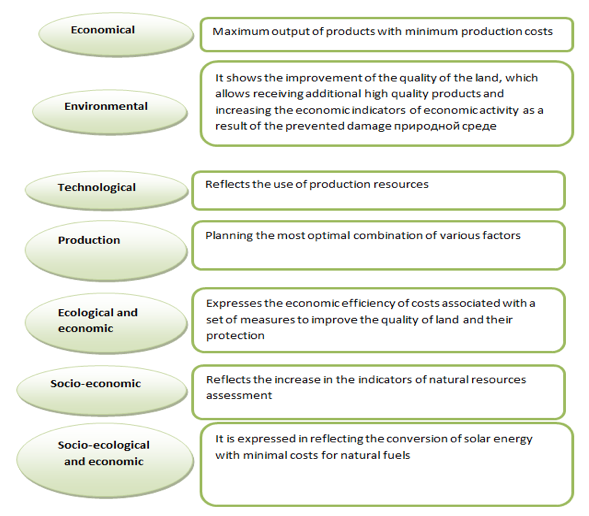
The effectiveness of agricultural production is a complex economic category. It reflects one of the most important aspects of social production - effectiveness (Alexandros, N., Alston, J. M. 2018).
Economic efficiency shows the final useful effect of the use of means of production and living labor, or, in other words, the return on aggregate investments. In agriculture, the criterion of efficiency is the increase in net output (gross income) with minimal expenditure of living and materialized labor. To measure the results of production with costs, the following types of economic efficiency are calculated: economic, ecological, technological, production-economic, ecological-economic, socio-economic, socio-ecological-economic (Fig. 2).
Fig. 2
Types of economic efficiency of agricultural production
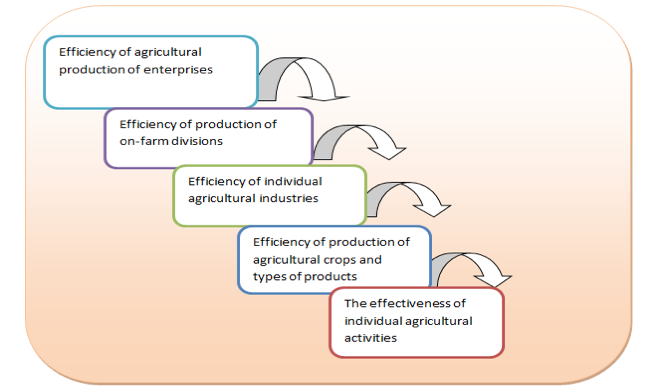
The problem of the efficient use of land resources in Russia, first of all, is connected with the irrationality of land use in the agricultural sector of the economy. The land and resource potential has significantly decreased over the last decades as a result of the withdrawal of a large area of agricultural land from circulation . In Russia, the share of agricultural land does not exceed 10% of the Russian territory. At the same time, the area of agricultural land in Russia is much larger than in the largest countries of the European Union. This indicates a huge reserve in agricultural production, which, unfortunately, is not yet used effectively enough (V. T. Vodyannikov, E.G. Lysenko, A.I . Lysyuk 2007, Kovalenko N.Ya., Agirbov Yu.I., Serova N.A. 2004).
For this period, there are a number of major problems that significantly affect the lowering of land use efficiency for agricultural production: first, in our modern world we are at the peak of scientific and technological progress, that is, we are using ever more new fertilizers and pesticides, and this is negatively affects the condition of the earth. Secondly, the artificial creation and modification of products. Thirdly, the problem of reducing the efficiency of agricultural land use is the export of products from the CIS countries (Fig. 3). There is practically no mechanism for monitoring the efficiency of agricultural land use in the country. The reason is the lack of a system for monitoring the quality of land. The programs that were developed to carry out a qualitative assessment of land have not been implemented due to a lack of financial means for their implementation by the state (Lenskaya T.I., . Latruff, L. 2013, . Khanbabaev T.G., Dogeev G.D., Velibekova L.A. 2015).
Fig. 3
Problems of lowering the efficiency of agricultural production
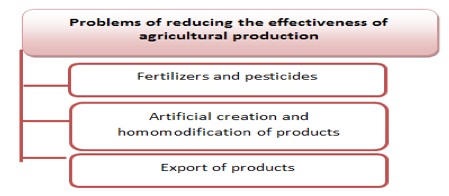
The problems of assessing the effectiveness of agricultural land use can be divided into four groups: organizational (state control, lack of a land monitoring system, lack of qualified specialists), legal issues (the problem of legislative regulation of the inviolability of private property, there is no clear definition of the legal status of demanded land), material and technical (weak technical equipment) and financial (Fig. 4).
Fig. 4
Problems of assessing the efficiency of agricultural land use
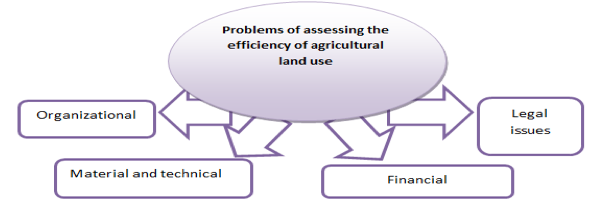
Recently, the role of anthropogenic factors affecting the qualitative characteristics of the earth has increased (Fig. 5).
Fig. 5
Types of anthropogenic factors
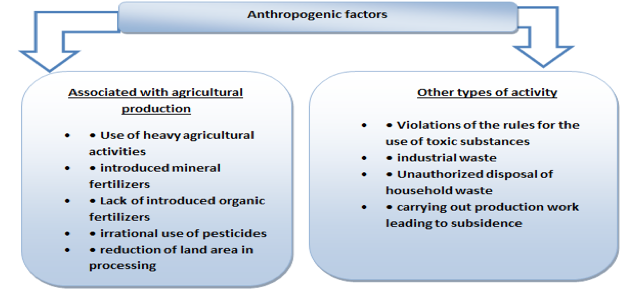
The deterioration in the quality characteristics of agricultural lands, expressed in their degradation and pollution, leads to undesirable economic, social, and even demographic consequences (Fig. 6).
Fig. 6
Varieties of degradation and pollution of agricultural land
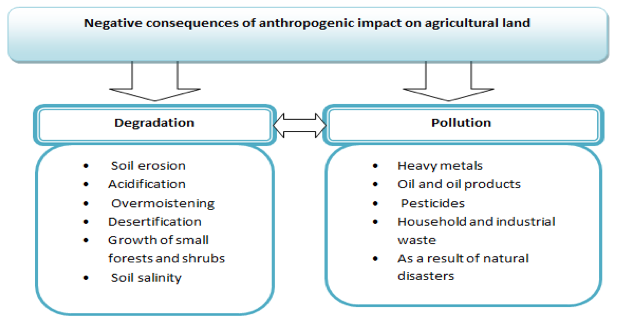
The negative economic effect of irrational use of land resources is expressed in reducing the yield of crop production and livestock production per 100 hectares of agricultural land, reducing the yield of major crops, increasing the cost of production, reducing the payback of production costs, and ultimately reducing the profitability of agricultural business .
The results of agricultural production depend on the effectiveness of the use of productive resources, primarily land. Economic efficiency of land use as a means of production is determined by comparing the results of production with the area or value of land. The definition of the effectiveness of land use has its own specifics. In modern conditions, the use of land in agriculture is considered effective, rational, when not only the output of output per unit of area increases, its quality increases, the cost of producing a unit of production decreases, but the soil's fertility still persists or grows, and the environment is protected.
The research method consists of ways to obtain information for assessing the efficiency of agricultural land use (Smagin B.I. 2007., Gusakov V.G. 2008, Pelikh S.A. 2012) At the first stage of the analysis of the use of land resources, it is advisable to analyze the composition and structure of land in comparison with the baseline indicators. Particular attention should be paid to the availability and specific gravity of the reclaimed and irrigated land in the land resources of the enterprise: drained and irrigated, as well as the change in these indicators, since experience shows that in recent years, in connection with the expensive maintenance of land reclamation facilities, such lands have been withdrawn from circulation or transferred in other categories (Kovalenko E.G., Korogodin I.T. 20014).
In this study, the following methods were used: statistical, analytical, comparative. The agricultural enterprise of OJSC "Malkovskoye", which is located in the territory of the Tyumen region, the village of Malkovo, was chosen as the object of the study of economic efficiency of agricultural land use. This enterprise plays a leading role in the agricultural sector and makes a significant contribution to the economy of the region. Currently, the population of the Malkovskoye Municipality is 2559 people, most of whom are engaged in the activities of the company under investigation, so the effectiveness of this production is very important for the region and for the residents themselves. It is necessary to constantly monitor in order to anticipate what investments need to be made now to get a competitive and popular product in the future, a competent analysis of the strengths and weaknesses of the organization, the introduction of modern strategic planning techniques for the long-term perspective of efficient production.
The economic efficiency of agricultural production is characterized by qualitative and quantitative indicators. The organization of agricultural production requires the availability of accurate data on the state of soil fertility. The solution of problems of effective land use today requires the organization of accounting and assessment of specific conditions of agricultural production for a separately processed site. It is known that even within the limits of one farm, and within the limits of an area, there are lands that differ significantly in terms of natural and economic fertility, which affects the results of production. The soil cover of the land areas of the enterprise is represented by soil varieties. Of these, gray forest soils prevail. In the farm, the average score of the general assessment of arable land is high enough and equal to 8.7. The natural and climatic conditions of the farm and the availability of large areas of hayfields and pastures make it possible to develop the crop and livestock sector.
Since the qualitative indicators of land used by the enterprise for growing crops did not differ from the baseline indicators at the time of the study, the analysis will be carried out according to quantitative indicators. In the analysis of quantitative indicators, data such as agricultural productivity, the value of gross output, profit, the area of agricultural land, the profitability of production were compared. The analysis of agricultural land use efficiency was carried out on the basis of the annual reports of OJSC "Malkovskoye" (Table 1), the study period is 5 years.
Conclusion on the table 1: The main indicators that characterize the size of the enterprise is the average annual cost of fixed assets which increased by 2,684 thousand rubles in 2017, compared to 2013, the value of gross output in 2017 rose from 2013 to 11915 thousand rubles. Also, the value of commodity output increased from 2013 and by 2017 it makes up 23,496 thousand rubles, but the total area of agricultural land for 5 years decreased by 278 hectares.
In general, the increase in the value of fixed assets indicates that there is a systematic expansion of the technical base of the enterprise, new machinery and technologies are being introduced. The growth of current assets, in turn, indicates the growth of the material base of the enterprise, which directly affects the growth rates (and, most importantly, the increase) of gross and marketable products, and hence the profit of the enterprise. In the economic literature, various approaches to assessing the use of land have been repeatedly considered. In particular, there have been attempts to find a general index (index), which would enable us to simultaneously determine the economic efficiency of land use and the level of development of the economy as a whole. But, often, these indicators were very conditional.
Table 1
Indicators characterizing the size of the enterprise
Indicators |
2013 |
2014 |
2015 |
2016 |
2017 |
1 |
2 |
3 |
4 |
5 |
6 |
The cost of gross output, thousand rubles |
91758 |
89036 |
109727 |
70096 |
103673 |
Cost of commodity output, thousand rubles. |
86930 |
78615 |
87476 |
105208 |
110426 |
Average number of employees, pers |
136 |
122 |
129 |
101 |
117 |
Average annual cost of fixed production assets, thousand |
50592 |
54610 |
58725 |
58570 |
53276 |
Average annual cost of circulating assets, thousand rubles |
67318 |
63364 |
54552 |
83192 |
75617 |
Total land area, ha |
928 |
928 |
928 |
760 |
650 |
including agricultural land |
928 |
928 |
928 |
760 |
650 |
arable land |
845 |
845 |
845 |
760 |
650 |
hayfields |
83 |
83 |
83 |
- |
- |
Power output, (horsepower) |
8402 |
7568 |
6657 |
6487 |
6306 |
If earlier the orientation was to increase the gross output of the economy, and this indicator took the leading place, at the present stage of development of farms, tendencies to the predominance of commodity output are traced.
The indicator most characteristic of specialization is the structure of commodity output, the analysis of which is presented in Table 2. The structure of commodity output is the percentage of its individual types in the total revenue of the economy from sale.
Conclusion according to the table2: Based on the analysis of the information received, it can be concluded that the bulk of the commercial output of OJSC "Malkovskoe" is the crop sector. In 2013, this share of marketable products was 88.52%, in 2017 -100% (the livestock sector ceased to exist in 2014, due to unprofitable production) of the total volume of commercial products of the enterprise. In plant growing, the main part is potatoes (an average of 45.23% over five years) and open-ground vegetables (44%).
The main economic indicators characterizing the specialization of the agricultural enterprise are the structure of the commodity output of agriculture and, above all, the specific weight of the output of the main industry, reflecting the level of specialization. The dynamics of production is presented in Table 3. Conclusion according to the table 3: According to the table, you can see the dynamics of production comparing the 2013 and 2017 in the positive dynamics, only potatoes remain. Negative dynamics in the rest of the crop sector can be justified by a decrease in the area of agricultural land, a low wholesale price for production products, an unwillingness to sell goods at a low price, with the subsequent benefit.
The branch of livestock production ceased to exist, due to unprofitable production, the total cost price of the goods was higher than the revenue (the revenue could not cover the material costs of labor, electricity, fuel, fodder).
Table 2
Composition and structure of commercial products
Types of products |
2013 |
2014 |
2015 |
2016 |
2017 |
|||||
Thousand. rub. |
% |
Thousand. rub. |
% |
Thousand. rub. |
% |
Thousand. rub. |
% |
Thousand. rub. |
% |
|
1 |
2 |
3 |
4 |
5 |
6 |
7 |
8 |
9 |
10 |
11 |
Crop production, total |
83777 |
88,5 |
86013 |
91,1 |
84736 |
100 |
101283 |
100 |
110678 |
100 |
Cereals and legumes |
4972 |
5,3 |
5551 |
6,1 |
6857 |
8,1 |
8158 |
8,1 |
6809 |
6,2 |
Potatoes |
36818 |
38,8 |
42356 |
44,7 |
43691 |
51,6 |
42388 |
41,8 |
54221 |
48,9 |
Open ground vegetable |
41987 |
44,4 |
38106 |
40,3 |
34188 |
40,3 |
50737 |
50,1 |
49648 |
44,9 |
Livestock, total |
10863 |
11,5 |
8410 |
8,9 |
- |
- |
- |
- |
- |
- |
Milk direction |
8062 |
8,5 |
7032 |
7,4 |
- |
- |
- |
- |
- |
- |
Animals for rearing and |
2801 |
3,0 |
1378 |
1,5 |
- |
- |
- |
- |
- |
- |
TOTAL |
94640 |
100 |
94423 |
100 |
84736 |
100 |
101283 |
100 |
110678 |
100 |
-----
Table 3
Dynamics of production
Indicators (centner) |
2013 |
2014 |
2015 |
2016 |
2017 |
2017 as% of 2013 |
1 |
2 |
3 |
4 |
5 |
6 |
7 |
Cereals and legumes, including corn for grain |
20808 |
7362 |
3811 |
9710 |
9138 |
-56,08 |
Potatoes |
34809 |
44250 |
41256 |
35855 |
42250 |
21,38 |
Vegetables |
36353 |
20871 |
22154 |
10386 |
29290 |
-19,43 |
Hay |
2383 |
548 |
- |
- |
- |
- |
Straw |
- |
978 |
41 |
- |
- |
- |
Silage of all kinds |
9450 |
7264 |
9398 |
- |
- |
- |
Flour, cereals, bran and other grain products |
32 |
33 |
92 |
1 |
- |
- |
Meat and fat |
- |
2 |
2 |
- |
- |
- |
Milk All |
7 |
12 |
20 |
- |
- |
- |
In each farm, economic indicators are used to estimate the economic efficiency of an industry. Production efficiency is a complex economic category. It reflects the operation of objective economic laws and shows one of the most important aspects of social production - effectiveness. It is a form of expressing the purpose of production. In order to determine how the enterprise develops, it is necessary to calculate a number of economic indicators. The data are shown in Table 4. Conclusion from the table 4: Analyzing the data in Table 4, we can conclude that the level of marketability is directly dependent on such indicators as gross yield and sales of products. The level of marketability in OJSC "Malkovskoye" in 2017 compared with 2013 increased by 11.77%. An important indicator of the economic efficiency of an agricultural enterprise is the production cost. From its level depends financial results of the enterprise.
Table 4
Economic indicators of production
Indicators |
2013 |
2014 |
2015 |
2016 |
2017 |
Implemented, a centner |
10834 |
8680 |
13539 |
14401 |
9501 |
Level of marketability, % |
94,74 |
88,3 |
79,72 |
150,1 |
106,51 |
Labor costs per 1 centner, person-hour |
2,3 |
2,1 |
1,98 |
2,2 |
2,2 |
The cost price is 1 centner, rub |
93399 |
98886 |
89161 |
107171 |
110678 |
The total cost price, thousand rubles |
86930 |
78615 |
87476 |
105208 |
110426 |
The sale price 1 tsentner |
0,57 |
0,58 |
0,55 |
0,56 |
0,85 |
Revenues from sales, thousand rubles |
104155 |
97203 |
136115 |
106856 |
112252 |
Profit (loss), thousand rubles |
18017 |
11020 |
33158 |
40223 |
10852 |
The level of profitability, % |
505,41 |
131,54 |
123,51 |
194,37 |
475,9 |
The production cost in OJSC "Malkovskoye" increased by 17,279 rubles, which had a negative impact on the activities of the enterprise itself, as this contributed to a decrease in the level of profitability.
Based on the above theoretical and practical materials, it is necessary to continue the development of methodological provisions for assessing the efficiency of agricultural land use in terms of preserving the quality of land resources and searching for the most cost-effective use of these lands. The most important problem for the effective use of agricultural land is the lack of a system for monitoring the quality of land, and therefore there is no up-to-date information on the state of agricultural land. With respect to land use or land tenure, rationality presupposes the expediency of productive and non-productive use of land by applying both intensive and extensive factors that ensure a constant increase in soil fertility. But the use of intensive factors should not lead to a decrease in the fertility of lands and their retirement from agricultural production. From the analysis of the activities of the agricultural enterprise, we have identified the inability to directly separate the indicators of the economic activity of enterprises with the indicators of land use. Without the application of any labor to the earth, it is impossible to use it effectively or ineffectively. The economic process of creating material goods is organically intertwined with the natural process of reproduction, which depends on the working conditions and, above all, on the quality of farmland.
Thus, for the efficient use of land resources and agricultural production, the following activities can be proposed, which are presented in Fig 7. The quality of land is not the only criterion affecting the increase in the efficiency of agricultural land use, which consists in reducing labor, material and financial costs while increasing output from the land.
Fig 7
Ways to increase the economic efficiency of
agricultural land use and agricultural production
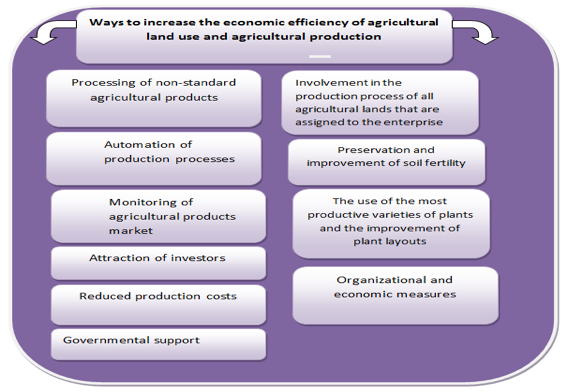
In the course of the work, the issues related to the current state of land resources were considered, the tasks and methodology for analyzing the efficiency of the use of land resources of the enterprise were disclosed, the efficiency of land use at OJSC "Malkovskoye" was analyzed and ways for improving the land funds of the enterprise under consideration were presented. To obtain high yields, measures should be taken to improve the use of agricultural land. The amount of agricultural production depends on how rationally it is used. As the society develops, the importance of land increases, which increases the need for careful monitoring and analysis of land transformation and use. To improve effective land use, it is necessary to distinguish the choice of the optimal technology of land cultivation, use of a balanced fertilizer system, increase the general cropping culture, optimize the on-farm organization of the territory, improve the planning and forecasting system, approach the choice of specialization more correctly, and assess the current market situation in the agrarian sector (Derbeneva E.V., Polushkina Т.М. 2017).
At the moment there is no unambiguous concept in determining the efficiency of land resources use, there is no single classification of types of efficiency, (in this article we proposed to make a classification). As the productive forces and production relations are changing in the development of the agricultural sector, their impact on production efficiency is changing, new projects are being developed, soil cultivation technologies are changing, and thus the forms of land use efficiency must be constantly developed.
1. Alexandros, N. World farming by 2030/2050: revision of 2012 / N. Alexandros, J. Bruinsma [Electronic resource] // Food and Agriculture Organization of the United Nations. - Access mode: <http://www.fao.org/docrep/016/ap106e/ap106e.pdf>. - Date of access: 01/30/2018.
2. Alston, J. M. Agricultural research, productivity and food prices / J. M. Alston, J. M. Beddow, P. G. Pardey [Electronic resource] // Giannini Foundation. - Access mode: <http://giannini.ucop.edu/media/are-update/files/articles/v12n2_5.pdf>. - Date of access: 01/25/2018.
3. Vodyannikov V. T., Lysenko E.G, ALysyuk.I., and others; The economy of agriculture [Text] / Ed. VT Vodyannikov. - Moscow: Colossus, 2007. - 390 p.
4. Kovalenko N.Ya., Agirbov Yu.I., Serova N.A. The Economics of Agriculture [Text]: A Textbook for Higher Educational Institutions / - M .: YURKNIGA, 2004. - 384 p.
12. Increasing Productivity and Competitiveness in Agriculture OECD [Electronic resource] // Organization for Economic Cooperation and Development. - 2011. - Access mode: <http://browse.oecdbookshop.org/oecd/pdfs/product/5111131e.pdf>. - Date of access: 01/25/2018.
5. Lenskaya T.I. Organizational and economic factors to increase the competitiveness of agricultural products: dis. cand. econ. Sciences: 08.00.05 / T. I. Lenskaya. - Minsk, 2013. - 152 c.
6. Latruff, L. Competitiveness, Productivity and Efficiency in the Agricultural and Agro-Food Sectors: OECD Food, Agriculture and Fisheries N 30 / L. Latruffe [Electronic resource] // OECD iLibrary. - Access mode: <http://www.oecd-ilibrary.org/agriculture-and-food/competitiveness-productivity-and-efficiency-in-the-agricultural-and-agri-food-sectors_5km91nkdt6d6-en?crawler= true >. - Date of access: 12/27/2017.
7. Khanbabaev T.G., Dogeev G.D., Velibekova L.A. Assessment of the efficiency of agricultural land use. International Scientific and Research Journal. - 2015. https://research-journal.org/economical/ocenka-effektivnosti-ispolzovaniya-zemel-selskoxozyajstvennogo-naznacheniya/
8. Smagin B.I. Economic analysis and statistical modeling of agricultural production [Text]: monograph. - Michurinsk: Michurin Publishing House. state. agrarian. University, 2007. - 153 p.
9. Gusakov V.G. The newest economy and organization of agriculture in the conditions of market formation: scientific search, problems, solutions / VG Gusakov. - Minsk: Institute of System Studies in the AIC, 2008. - 431 p.
10. Pelikh S.A. Innovative investment environment in the agro-industrial complex of China and Belarus: analysis, problems, solutions / SA Pelikh, Van Yaotian. - Minsk: Law and Economics, 2012.-176 p.
11. Saubanov K. R. Competitiveness of regional agriculture in the Volga Federal District: dis. Cand. econ. Sciences: 08.00.05 / K.R. Saubanov. - Kazan, 2010. - 176 c.
12. Kovalenko E.G. Modernization of the mechanism of sustainable development of rural areas / E.G. Kovalenko, T.M. Polushkina, O. Yu. Yakimova, EV Avtaykina, OO Zaitseva, KS Sedova / / Monograph / Under the general editorship of E. G. Kovalenko. - Moscow. 2014.
13. Korogodin I.T. An Effective Mechanism for Regulation of Zemological Relations / IT Korogodin // Land Management, Land Cadastre and Monetoring. - 2014. - No. 3. - P. 23-27.
14. Derbeneva E.V., Polushkina Т.М. Analysis of the state of agricultural land of the Republic of Mordovia / / International Student Scientific Bulletin. - 2017. - No. 1 .;
https://www.eduherald.ru/en/article/view?id=16803 (reference date: 01/01/2018).
1. Tyumen Industrial University, Volodarsky Street, 38, Tyumen, Russia, 625000. Contact Email: irina1983kust@gmail.com
2. Tyumen Industrial University, Volodarsky Street, 38, Tyumen, Russia, 625000
3. Tyumen Industrial University, Volodarsky Street, 38, Tyumen, Russia, 625000
4. Tyumen Industrial University, Volodarsky Street, 38, Tyumen, Russia, 625000